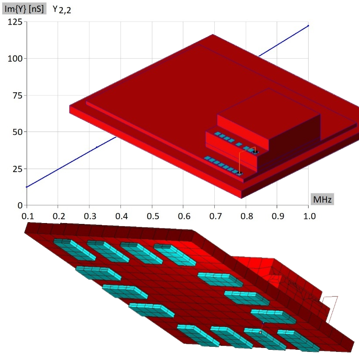On-Chip Capacitances
03-Mar-2014

03-Mar-2014
This report describes use of WIPL-D Software suite for analysis of self capacitance and the capacitances between the pads and associated connecting wires both being the parts of a relatively small chip (2-3 mm). The frequency range of interest is between 10 kHz and 10 MHz, which makes this on-chip capacitance calculation problem to be referred to as extremely low frequency problem.

WIPL-D Pro a 3D EM method-of-moments (MoM) based solver is typically used as high frequency simulator which can be used to simulate problems even in physical optics region. Nevertheless, providing that a special care is exercised, in terms of structure modeling and setting the project parameters, it can be successfully used for simulations at low frequency.
In this particular example, the chip geometry can be modeled in two ways-using WIPL-D Pro or using WIPL-D Pro CAD. When using WIPL-D Pro, the model is built from wires and plates, or using higher-level entities (objects). In that case building of a model is actually closely related to manual definition of the mesh. On the other hand, with WIPL-D Pro CAD a model is built from solid bodies using a choice of manipulation commands, and a model structure is meshed automatically. Models can be made from numerous built-in primitives or imported in popular CAD file formats. As the general chip geometry can vary from relatively simple to very complex, the modeling using WIPL-D Pro CAD has certain advantages.
In the entire simulation range, the behavior of the device is linearly proportional to frequency. Low frequency chip behavior can be obtained by extrapolation of result at higher frequencies. It is enough to perform this simulation of the chip at single frequency in the upper frequency bands and to assume that the same capacitance is preserved at lower frequencies.
In the particular case of low frequency simulations double precision with enhanced accuracy is required for highly accurate results. A standard desktop computer with 4 cores has been used resulting in simulation time in order of several minutes.
Section: Low Frequency
For full version of the document, please check the following pdf.